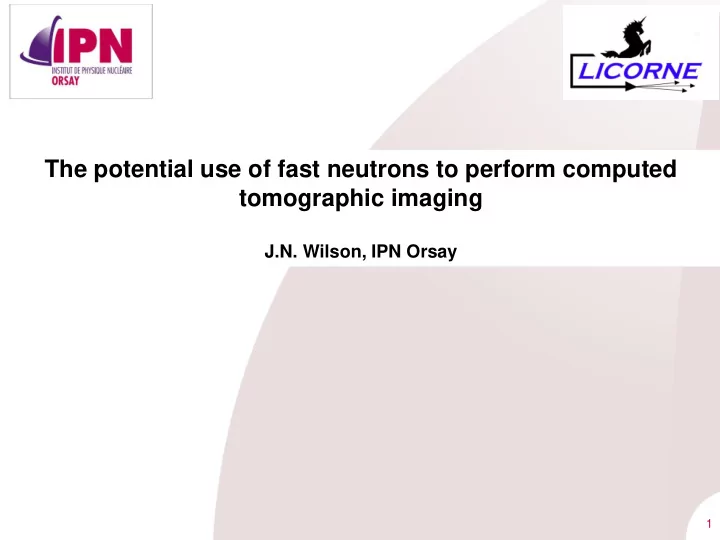

The potential use of fast neutrons to perform computed tomographic imaging J.N. Wilson, IPN Orsay 1
The first x-ray image Willhelm Röntgen - 1895 2
x-ray computed tomography Allan M. Cormack & Godfrey N. Hounsfield Nobel Prize in Medicine 1979 3
x-ray computed tomography principle 4
5
BAM x-ray CT setup Bundesanstalt für Materialforschung und prüfung , Berlin, Germany 6
CCD Detection System (2000x2000 pixels) For a 2D CCD detector arrays, scattering into other pixels is a big issue. Many of the counts in a pixel do not come from direct paths but from scattered paths. 7
8
9
10
Large Object x-ray CT LINAC: 500 keV electrons 11
12
Mass attenuation coefficients 13
Thermal neutron imaging facilities ORPHEE/ISIS (CEA Saclay, France) Helmholtz Zentrum (Berlin, Germany) MLZ (Munich, Germany) PSI (Switzerland) ESS (Lund, Sweden) • Complementary to x-ray CT • High penetration for high-Z materials • Potential activation of the sample • No information on isotopic composition • Attenuation coefficients vary wildly with material type • High efficiency detection system is difficult to build 14
Potential applications of Fast Neutron Tomography Border/airport security (e.g. detection of explosives in suitcases) Nuclear Industry: Characterisation of nuclear waste packages Cultural Heritage: Imaging inside precious artifacts and objects Precision quality control for industry Non destructive characterization of geological samples (e.g. Metorites) 15
H 2 pressure and low control system Hydrogen gas cells 16
Experimental Setup 17
Non-destructive, penetrating probes of sample compositions: A new application for directional fast neutrons 18
IPN Orsay scanning table 19
20
Conclusions/Summary Fast neutron imaging would be an interesting potential application for IFMIF/DONES Look for special niche applications which are complementary to x-ray or thermal neutron CT Requires very well collimated neutron beam + fast neutron detection system (e.g. highly segmented 1D or 2D liquid scintillator array) Production and ejection of secondary particles (gammas, neutrons) gives important additional information on the object internal structure Secondary particles are produced with 14 MeV neutrons mainly via (n,n ’γ ) and (n,2n) reactions Detection of emitted gamma rays will require additional gamma ray array detection system 21
lundi 18 avril 2016 22
23
Complementarity neutrons/photons Radiograph of an analog camera: by Thermal neutrons (top) by X-rays (bottom). While X- neutrons rays are attenuated more effectively by heavier materials like metals, neutrons make it possible to image some light materials such as hydrogenous substances with high contrast: in the X-ray image, the metal parts of the photo apparatus are seen clearly, while the neutron radiograph shows details of the plastic parts. X-rays 24
lundi 18 avril 2016 Neutron radiography/ tomography Laboratoire d'Archéologie Moléculaire et Structurale 25
Recommend
More recommend